Italians take coffee seriously and Italian coffee culture has been honed through the centuries to a veritable art form.
After all, Italy is the country that introduced coffee to Europe and where every year almost 6 kg of coffee are consumed per capita!
So, it’s not surprising that there is a whole system of rituals and behaviours about coffee here. Known as il galateo del caffè this is the Italian coffee etiquette which is rigorously observed. Its rules are not difficult to follow. They have been developed and perfected in order to extract the maximum flavour and pleasure out of a small cup of coffee.
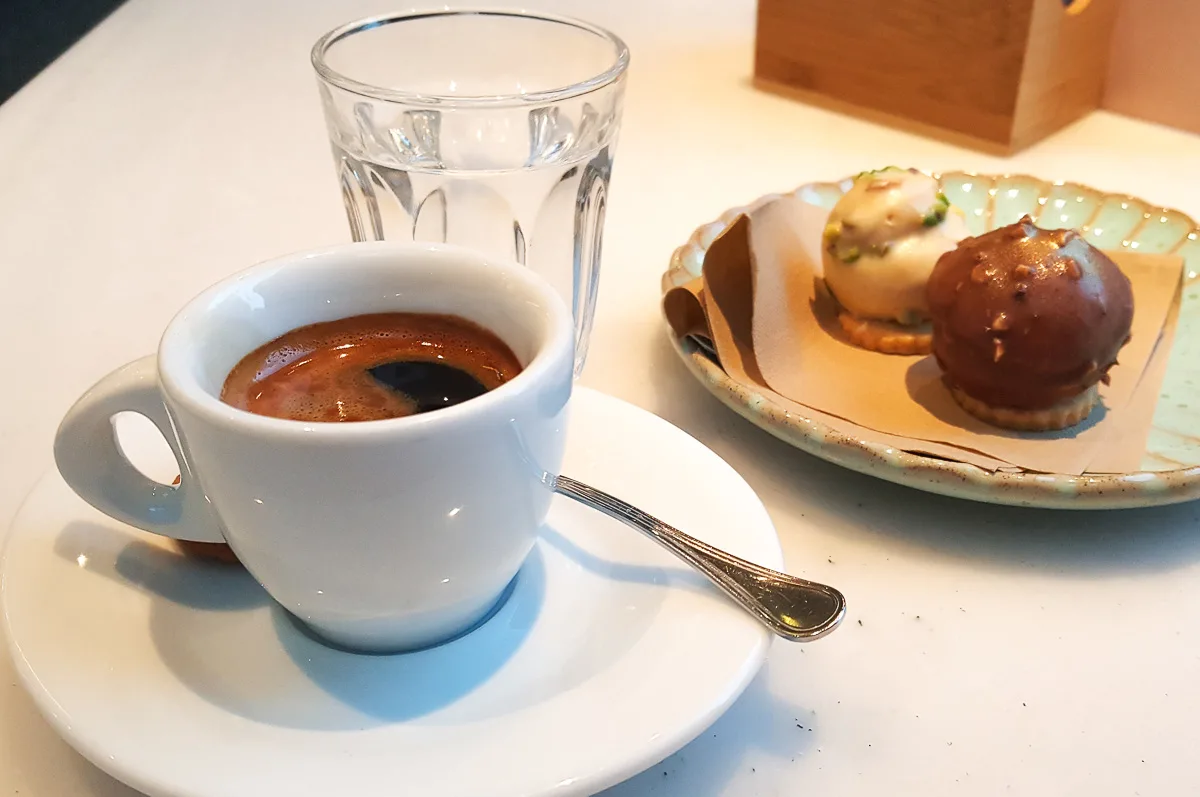
At the same time, trying to order your first cup of coffee in Italy can be a confusing experience. First, you may be shocked to discover that to have a coffee Italians head not to a fancy coffee shop but to the bar. Second, coffee sizes in Italy may seem absolutely tiny next to what the international coffee chains have conditioned us to think of as a normal coffee cup.
Fear not!
Italian coffee culture makes a lot of sense once you know how it operates. Think of it as a new dance! At the start it may all seem quite difficult, exhausting even. Once you’ve learned the steps though, it all becomes logical and second nature. Plus, the award – a cup of proper Italian coffee – is more than worth it.
Take it from me! I spent six years living in Italy and by the end popping down to the bar for a coffee had become an almost daily ritual for me. A ritual that took me a while to decipher and feel comfortable with. Once everything clicked into place, I was like: ‘This makes so much sense!’So, to make it easy for you, in this blog post, I will share with you the 19 rules of Italian coffee culture. Step by step, I will take you through its tenets and secrets. I will even admit to the coffee mistakes I made myself. This way, before you know it you will be taking and enjoying your coffee like a true Italian both in Italy and back home.
Have a look!
19 Rules of Italian Coffee Culture or How to Drink Coffee Like a True Italian
1. Excellent Coffee Is Everywhere in Italy
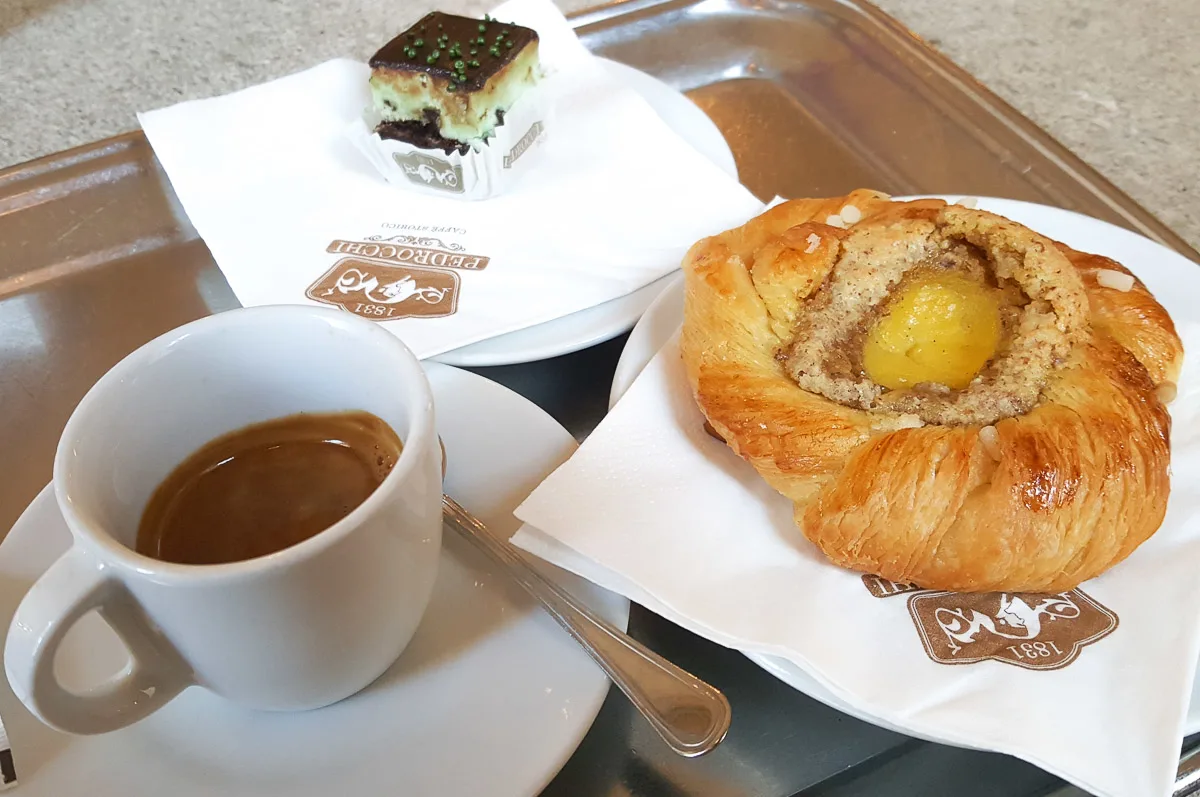
One of the best things about Italy is that excellent coffee is everywhere here. You don’t need to go to a specific coffee shop just to have a proper cup of coffee. Even the smallest Italian bar has a top of the range coffee machine, knows how to use it, and makes great coffee.
I love it that in Italy excellent coffee is a universal right. Everyone has easy and inexpensive access to it. Even vending machines here make very good coffee.
Having access to great coffee in Italy is not the preserve of a few connoisseurs who may spend years and thousands on coffee equipment and blends. No matter what their social or financial position in life may be, the Italians as a whole know about coffee and how to drink it.
In fact, in my six years of living in Italy and having coffee outside of the house almost daily, I had subpar coffee twice. I didn’t hold it against the two respective places where I was served it but apparently the Italians did. For both places went out of business within six months of opening.
2. For a Coffee in Italy Head to the Bar
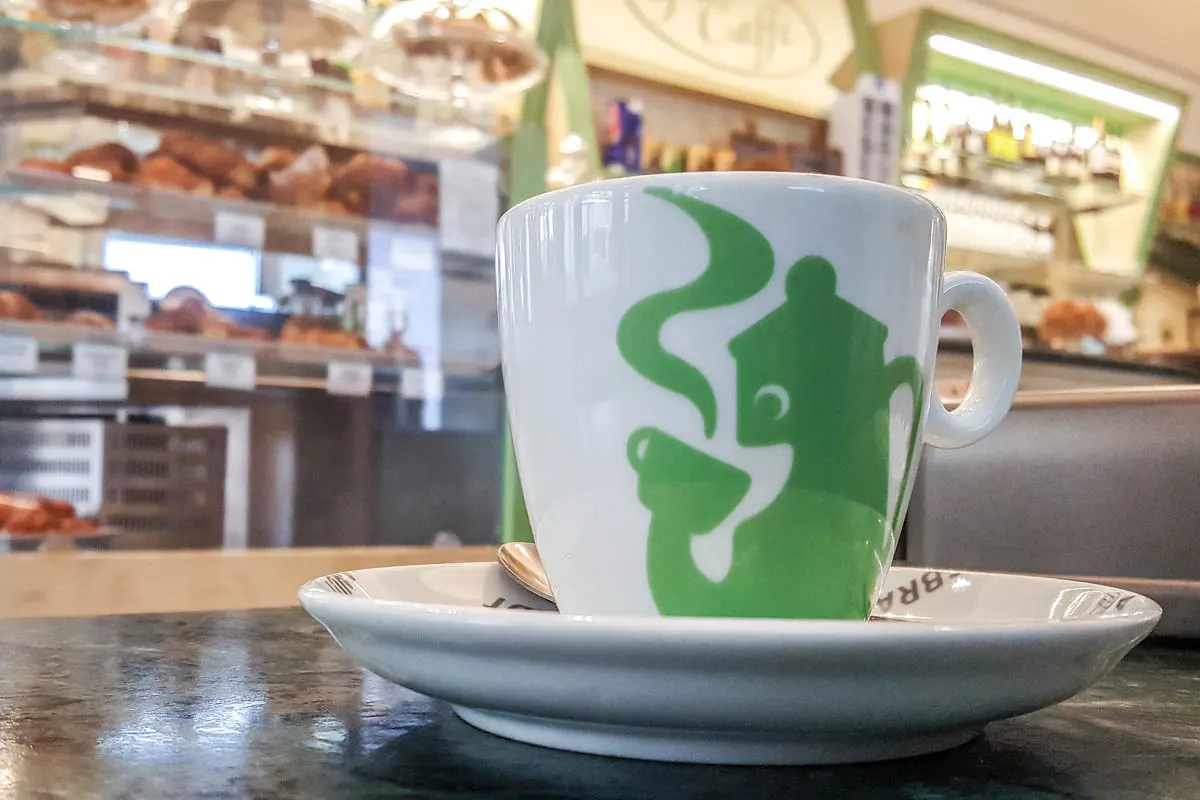
For their daily coffee, Italians head to the bar.
You know how all over the world a bar is a place where people go to mainly to drink alcohol and to meet with friends after work?! Well, a bar in Italy is a bit different than that.
Italian bars open early in the morning and operate all throughout the day. They are a perfectly fine place to visit with your kids. This is where you head to for a traditional Italian breakfast – cappuccino and a pastry (locally called cornetto or brioche). And the place you pop in to have an espresso during your mid-morning break. An Italian bar may also serve light lunches or sell sandwiches (called tramezzini) and other such light bites. In the evening, alcohol drinks are also served.
The main function of an Italian bar though is simply to serve great coffee.
In fact, the best way to learn about Italian coffee culture is to spend a bit of time in an Italian bar observing the locals. You will see little old ladies with perfectly coiffed hair, businessmen dressed to the nines, workers on their morning break, students popping in between lectures – all indulging in a cup of proper coffee.
Observe how they interact with the barista, how they lean against the counter, how they mix their coffees, how they hold the cup, how they sip. It’s a whole coffee university in the span of a few minutes.
Yes, there are cafes in Italy, too. Called caffè, these often are elegant establishments some of which have been in operation for dozens if not hundreds of years. A case in point are the historic Caffè Bontadi in Rovereto which was established in 1790 and Caffè Pedrocchi in Padua which was established in 1831. And, obviously, the very famous Caffè Florian in Venice which is the oldest coffee shop in the world as it first opened its doors in 1720.
An Italian pasticceria is another place to head to for a coffee in Italy. A pasticceria is literally a patisserie and it sells all sorts of sweets and cakes in addition to great coffee, too.
3. Barista is a Respected Career in Italy
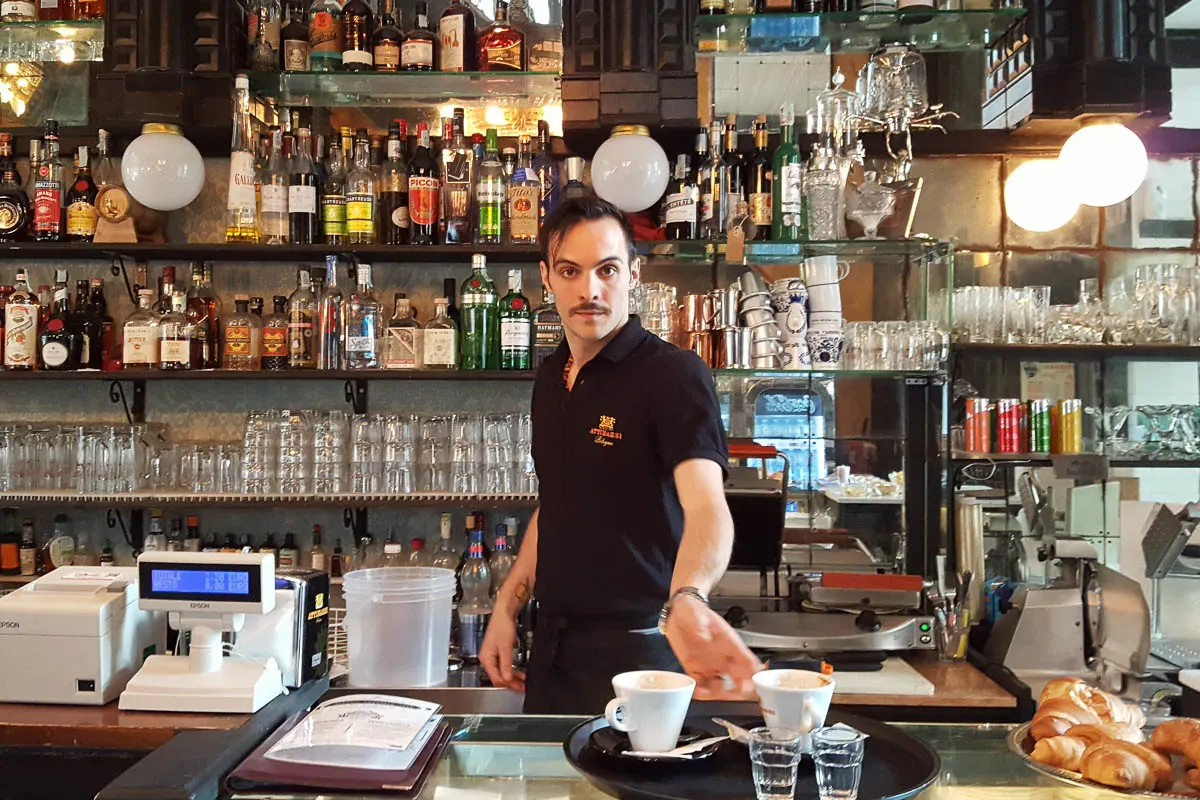
The person who will make your coffee in Italy is known as a barista.
Barista is a popular and respected profession in Italy. There are over 400,000 people working in bars here making hundreds of coffees every day. While being a barista in other countries often is a job taken by students or people seeking employment while working towards professional development in a different field, being a barista in Italy can be a lifelong career. Curiously, Achile Gaggia – the inventor of the first modern steamless coffee machine – was a barista in Milan. He used a revolutionary piston mechanism which allowed him to make an espresso in 15 seconds. Nowadays, the Gaggia coffee machines are ones of the best in the business.
The Italian barista has coffee-making down to a fine art. His or her expert hands control and fine-tune all the elements that need to come together in order to produce the perfect cup of coffee. A good barista here understands the qualities of the different coffee blends and roasts, knows how to maintain and use different coffee machines and how to adjust the coffee grinder depending on many little details. Above all, a good barista knows how to keep a friendly rapport with the clients, many of whom return day after day for their daily coffee.
As such, being nice and pleasant to your barista is a must. Greeting him or her on the way in and out of the bar is considered good manners.
Baristas in Italy, traditionally, don’t expect a tip. In some places, especially in more touristy spots, I have seen a small tip-box left on the counter. This still is more of an exception than the rule though.
4. One Coffee Size Fits All
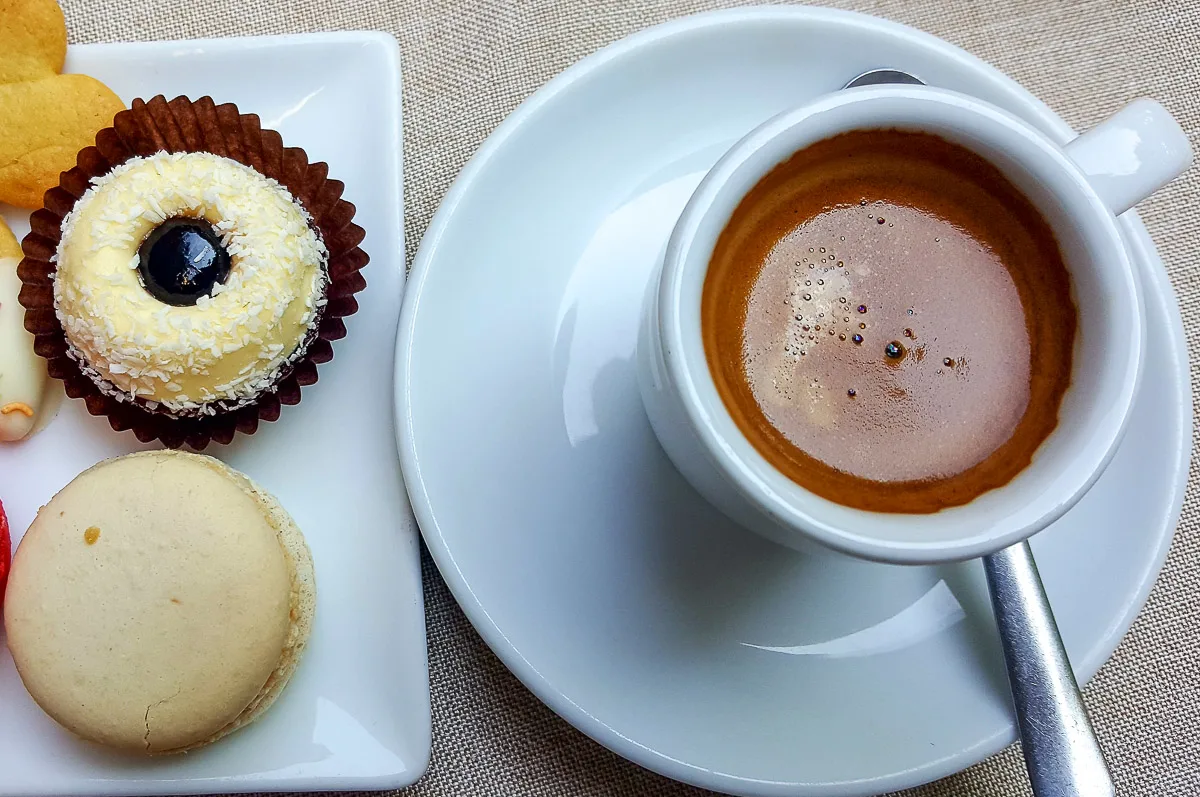
Don’t expect complicated sizes and bucket-shaped coffee cups in Italy. Instead, there is a single-size cup for every Italian coffee type. An espresso, for example, is served in small cups which are slightly flared at the top. Cappuccino cups are rounded and restrained in size.
After all, coffee in Italy is not to be nuzzled or drunk over a long period of time. It’s not a bucket to carry around with you while showing off the brand of a particular coffee company or how ecologically minded you are by having your own reusable coffee cup.
Coffee in Italy is very much served and consumed on-site. Sizes are small, even tiny compared to what international coffee chains have made us believe that an acceptable coffee size is. Water and milk are not used liberally to inflate the sizes in order to make us feel that we are getting more for our buck.
Coffee here is very much an experience to have in the present moment. It is a truly strong and very flavoursome drink to enjoy at its very best. You order, you are served, you sip your coffee, you enjoy the flavour at its best, your finish, you move on with your day.
Nothing to carry with you, nothing to nuzzle from all throughout the day, nothing to use as an emotional aid. It’s all about flavour at its best and having a moment or two of pleasure and relaxation throughout the day.
5. Stand at the Counter or Sit at a Table
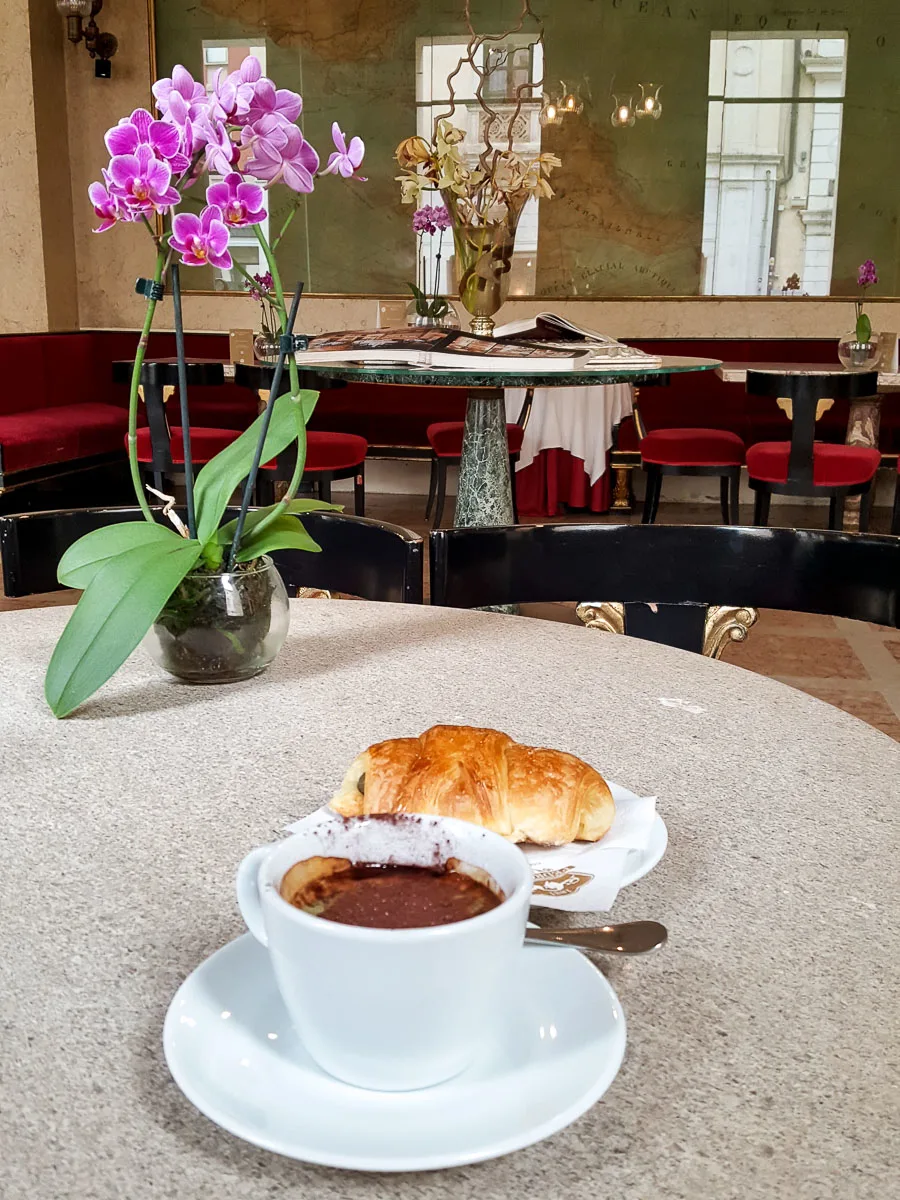
When ordering a coffee in Italy, you have two choices where to take it:
- al banco (in English, at the counter) – you remain upright and have your coffee leaning against the counter.
- alla tavola (in English, at the table) – you sit at a table and a member of staff takes your order.
It is very interesting to observe the Italians having their coffees at the counter. From entering the bar to ordering their coffee, having it and leaving the bar, the whole ritual on average takes 6-7 minutes (based on a purely non-representative observation I once conducted in an Italian bar over half an hour).
During this time, the Italians are either in a world of their own, just enjoying their coffee and thinking about their own stuff or animatedly talking to someone, usually a friend or a colleague they have come to the bar with.
Walking into a bar and seeing the crowd around the counter can induce stress in the foreigner trying to order his or her first coffee in Italy. It’s not always clear at a first glance who is waiting and who has already been served.
Just hang back for a minute and observe the proceedings. You may soon notice people with cups in front of them (they have been served), people with saucers in front of them (they are waiting for the barista to place a cup of freshly-made coffee on the saucer), people holding little white pieces of paper (they are waiting to pay), and people who have caught the eye of the barista and are placing their order.
This is exactly what you want to do – catch the eye of the barista by greeting him or her and then place your order.
Alternatively, simply pick a table, sit down, make yourself comfortable, read a newspaper, check your emails, and before you know it a member of staff will come to take your order.
6. Coffees Have Italian Names
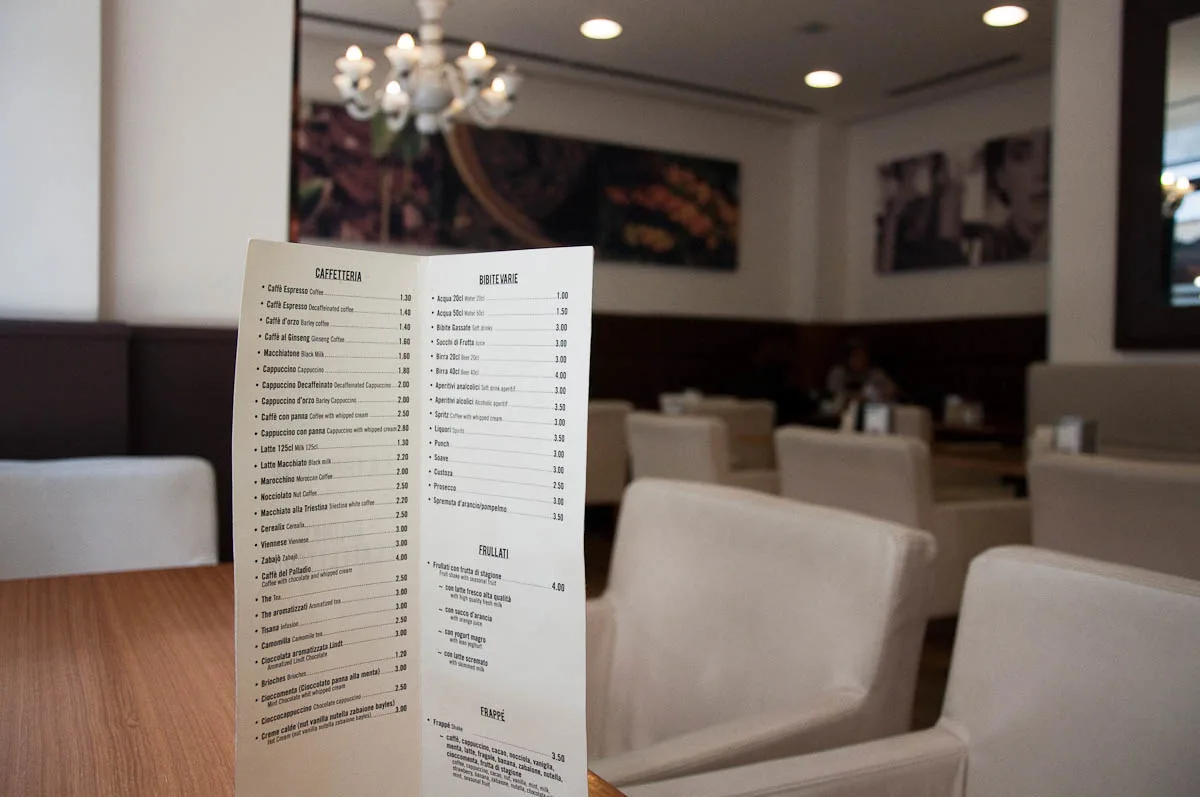
When ordering a coffee in Italy, it’s expected to use the proper Italian name for the coffee drink you want to get. After all, the Italians have spent centuries coming up with the right names and the correct way to prepare many of the most popular coffee drinks in the world. So, it’s only polite to stick to their established vocabulary.
Here are some simple pointers to help you along with feeling and acting more local coffee-wise:
- If you want an espresso, the Italian thing to say is un caffè. If by the force of habit you say un espresso, don’t worry too much. It took me a long time to get out of the habit of saying un espresso and to start saying un caffè. Baristas were very understanding. Just never ask for ‘un expresso’. There is no such thing!
- If you want an espresso with more water, this is called un caffè lungo.
- If you want a double espresso, you need to ask for un caffè doppio. Bear in mind that Italian espresso is very strong. So, only order a double if you really, really need it.
- If you want a cappuccino, the locals often call it simply cappuccio.
- If you want just a touch of milk in your coffee, ask for a caffè macchiato. This is an espresso ‘marked’ with a tiny quantity of milk/milk froth.
- If you want an americano, ask for it. Don’t worry that you will not be understood or that you will be judged for your coffee choice. However, an americano coffee in Italy is served as an espresso in a deep cup with a small jug of hot water for you to dilute the espresso precisely as much as you want.
- If you want a latte (and you are not in a fancy coffee shop at Venice or Bergamo airports) then order a caffè latte otherwise you may be served just the milk in a glass.
- If you want something even stronger than an espresso, then go for a caffè corretto – this is an espresso with a shot of liquor in it.
- If you want to give my personal favourite a try, order a caffè con panna. This is an espresso with a huge dollop of freshly whipped cream. Yum!
Bear in mind that bars in Italy not always have a coffee menu at each table or on a blackboard behind the counter. As such, it’s always a good idea to know how to order the coffee you want to have.
7. Paying for Your Coffee
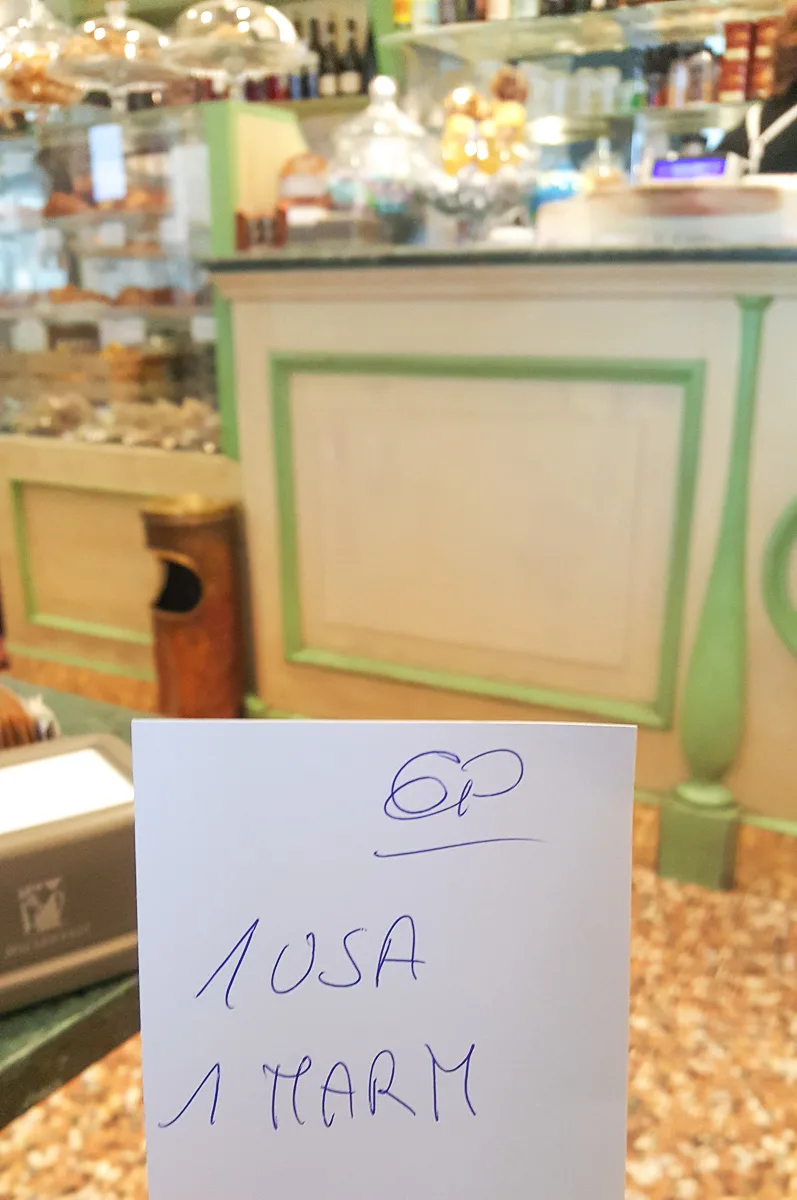
When you order a coffee in Italy, usually, you will be served your coffee and handed a small piece of paper with your order scribbled on it. When you are ready to pay, you take this piece of paper to the cashier behind the till. He or she will tell you how much you owe, will take your payment, and give you any change you may be due.
You can see above one such piece of paper I was given in one of my favourite bars in Vicenza where I used to live. I found it very funny at the time and thus took a photo of it. I had ordered an americano and they scribbled ‘1 USA’ on my receipt.
Sometimes, they don’t give you a piece of paper at all. Then, you simply need to go to the counter and tell the person who mans the till what you have ordered. This was the case in my favourite patisserie in Vicenza. There was a big element of trust and I never saw anyone abusing it.
Now, some Italian bars and cafes operate slightly differently. In so that, you first need to go to the cashier, tell him or her what you want to order and pre-pay. The cashier will then give you a receipt. You take the receipt to the bar counter where the barista will get your order ready.
Pre-payment is usually expected in bars and cafes which are in spots with a heavy footfall. For example, at train stations, airports, and busy places around the Italian towns and cities.
8. Cappuccino is a Morning Drink
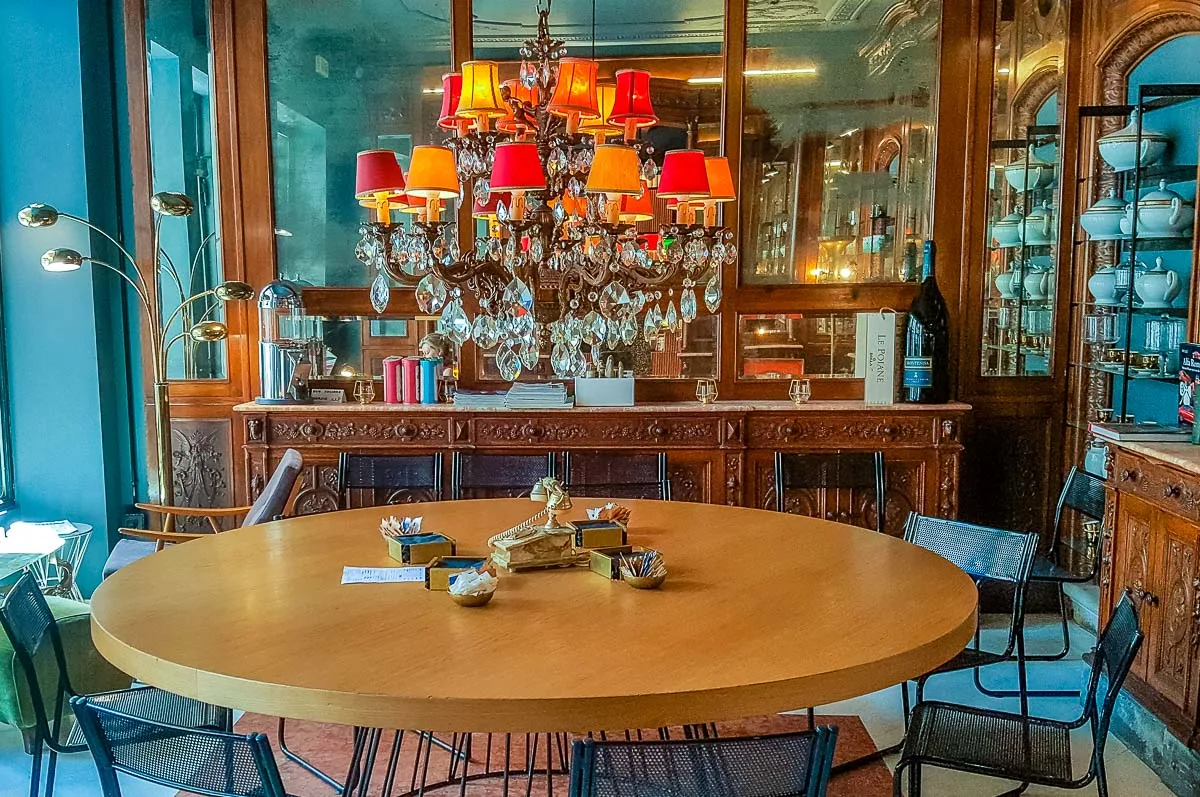
Coffee with milk is strictly a morning drink in Italy. Starting the day with a cappuccino and a pastry (called cornetto or brioche in the different parts of Italy) constitutes a traditional Italian breakfast.
Italians consider coffee with milk too heavy to have after lunch and dinner. You will not be refused service if you order a cappuccino in the afternoon or after a substantial meal, but in general, this is not a thing the locals do.
I never had a chance to break this rule of the Italian coffee culture, as I don’t drink milk. While I love cream, cheese, and ice-cream, for some reason milk has something about it that really puts me off. So, unfortunately or fortunately, I have never had a cappuccino in my life.
9. Espresso All Through the Day (and Night)
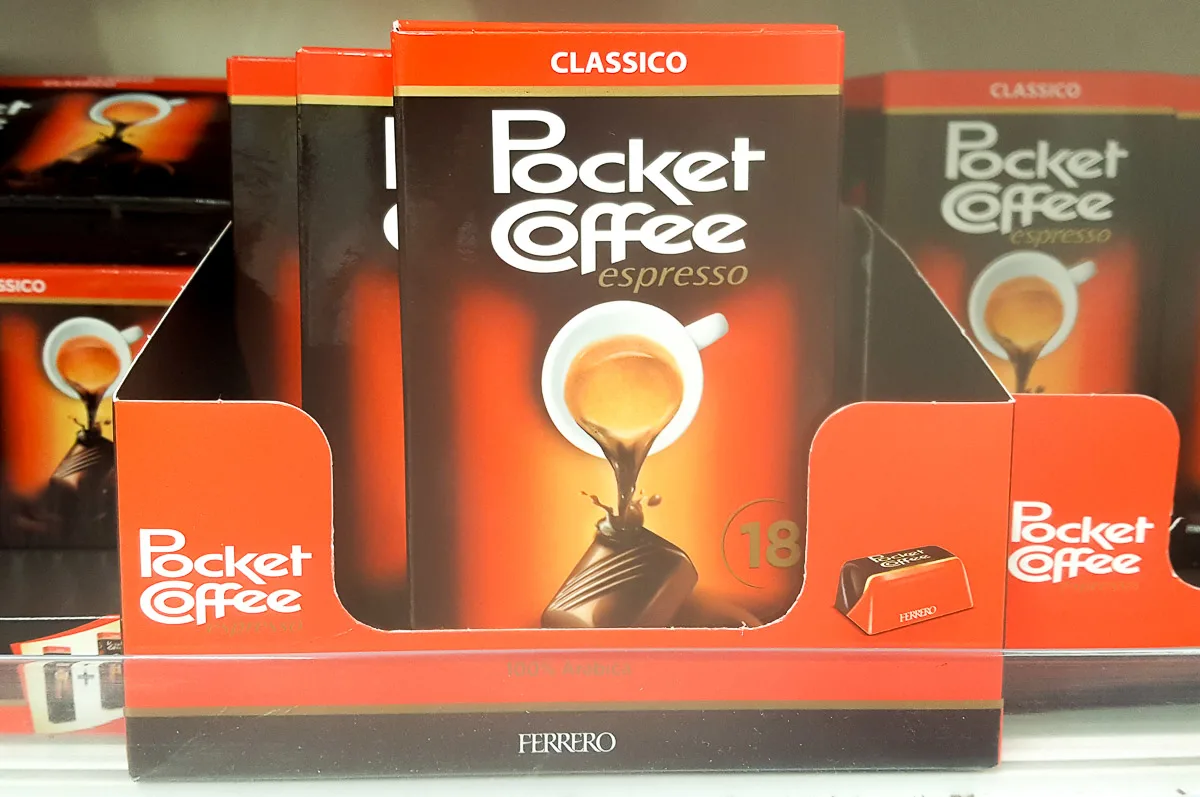
Espresso really rules in Italy and can be taken at any time of the day. It is especially popular at mid-morning and after lunch and dinner.
Don’t forget that espresso is customarily called caffè in Italy.
Italians love their caffè so much that they even have chocolates (pictured above) filled with a shot of espresso. There is a decaf version of the chocolates, too. This way, if you can’t make it to the bar, you can still have an espresso (or two) when you need it.
10. Water Comes Before Coffee
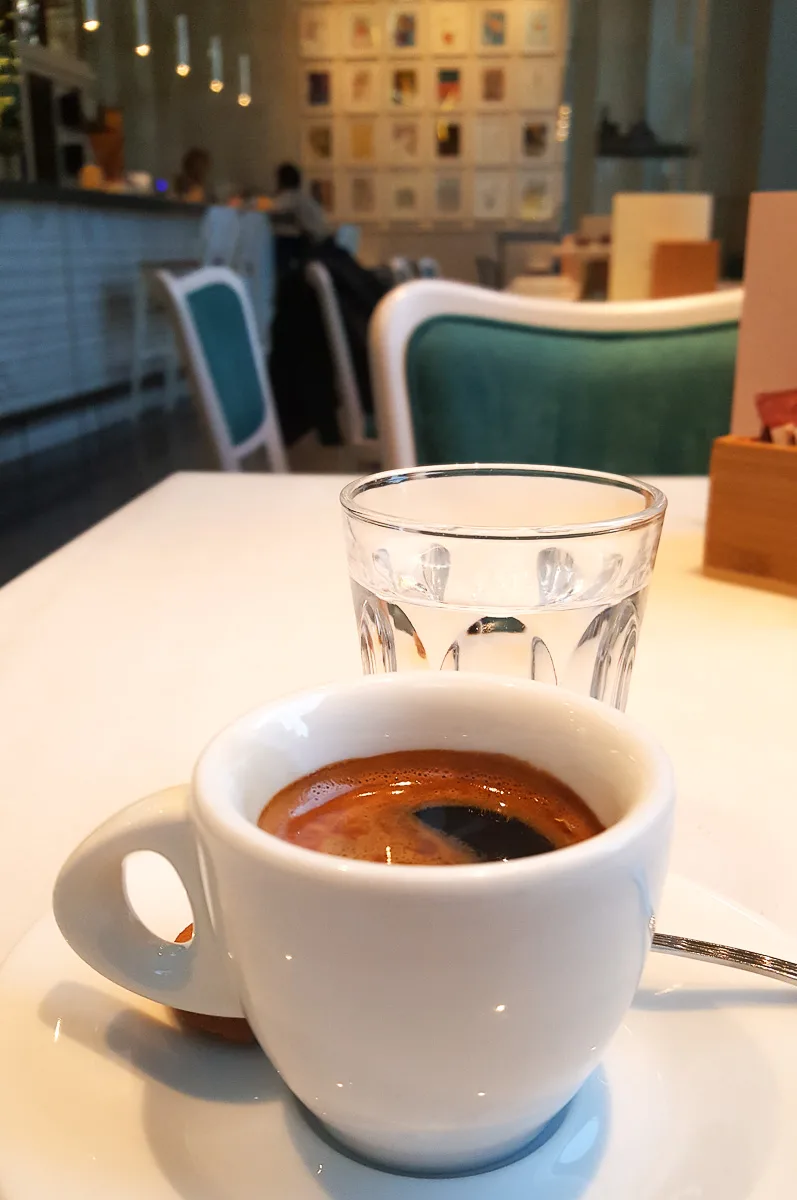
To fully appreciate the flavour of a proper Italian caffè, first, you need to take a sip or two of water. The water cleanses your palate and prepares it to fully appreciate the coffee’s aroma which is composed of 800 different molecules.
Sometimes, when you order a coffee in Italy, the barista automatically gives you a small glass of water free of charge. More often than not though, you need to order it separately and then pay for it. It doesn’t cost much. It’s around 0.50-0.70 euro which is more than worth it if you want the full coffee experience.
I have to admit that I resisted adopting this rule of the Italian coffee culture for a very long time. More fool me! Even a small sip of water before having your coffee opens a whole world of sensory delights. The coffee hits spots and corners in your mouth that you didn’t even know you had. The flavour feels richer, more textured, it’s like a whole symphony of coffee notes.
11. Mixing Is a Must
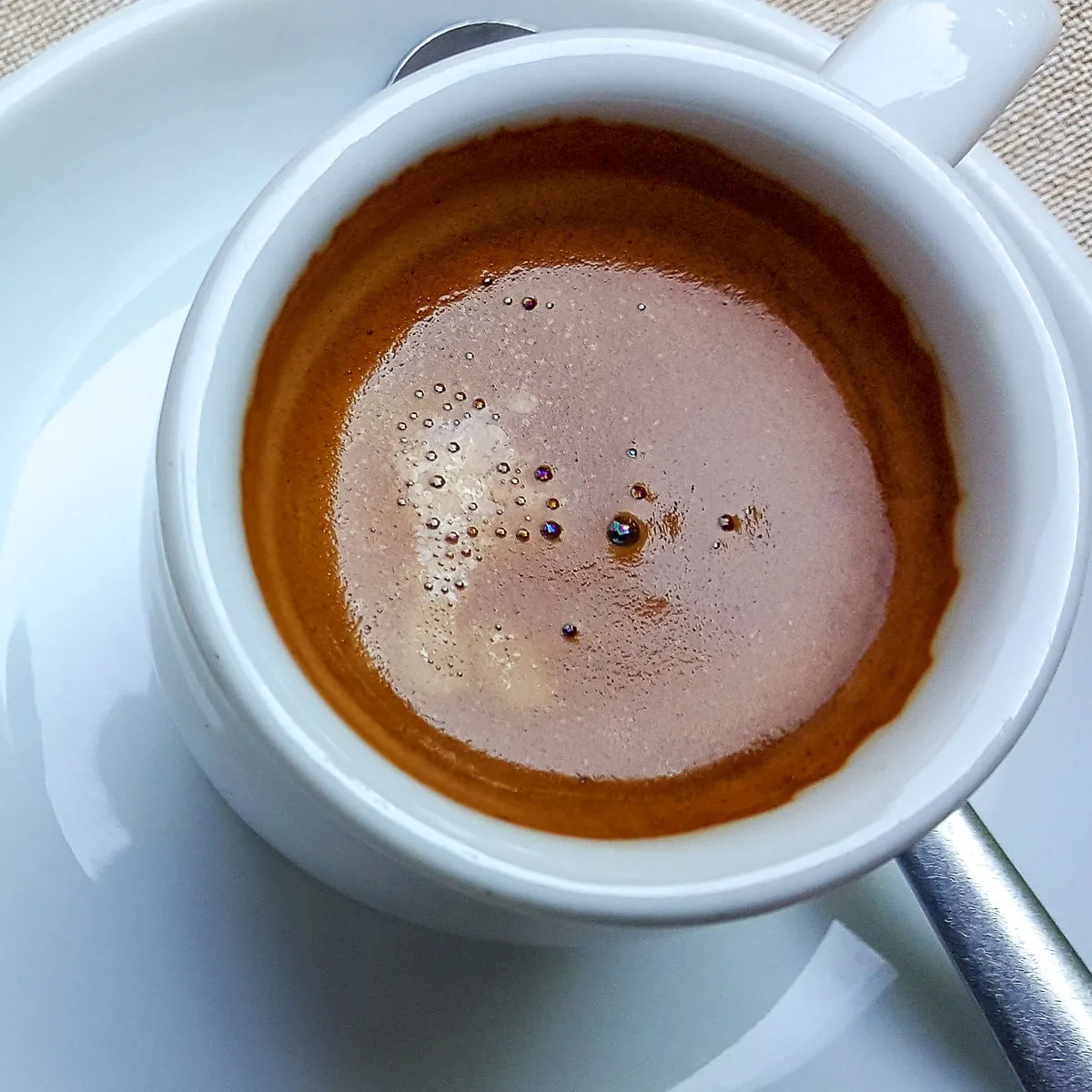
Even if you take your coffee without sugar, you still need to mix it before drinking it.
A tiny coffee spoon is always served with your coffee in Italy. This is not just for decoration. Use it to mix your coffee by moving the spoon lightly from the top of the cup to the bottom; never clockwise or anticlockwise. Take care not to hit the walls of the cup as the noise produced is considered unpleasant.
Mixing is the only way to distribute well the coffee blend’s aroma and flavour. Hence, it enhances your coffee experience.
12. Coffee Spoons Are Not for Licking

Italians consider licking your coffee spoon after mixing your coffee a sign of very bad manners. They simply place the spoon back on the saucer and get on with drinking their coffee.
I have to admit that at the start of my life in Italy, I used to break this particular rule of the Italian coffee etiquette all the time. I could never resist the tiny bits of crema that get stuck to the spoon. Crema, in a nutshell, is the natural layer of coffee oils which forms on top of the espresso thus helping it preserve for longer its intense and irresistible flavour.
In any case, I soon established that the crema bits on the coffee spoon didn’t taste very nice on their own. It’s much nicer instead to start sipping your coffee asap thus taking advantage of its full aroma and flavour. So, licking your coffee spoon doesn’t add anything to the Italian coffee experience. It just delays the enjoyment of the actual coffee.
Talking about coffee spoons and Italian coffee culture, there is another faux-pas to avoid here. Never leave the coffee spoon in the cup while drinking your coffee. It’s uncomfortable and it makes you twist your face to avoid the spoon. Plus, it’s quite dangerous, too in case the spoon hits you in the eye.
13. Observe the Two-Minute Rule
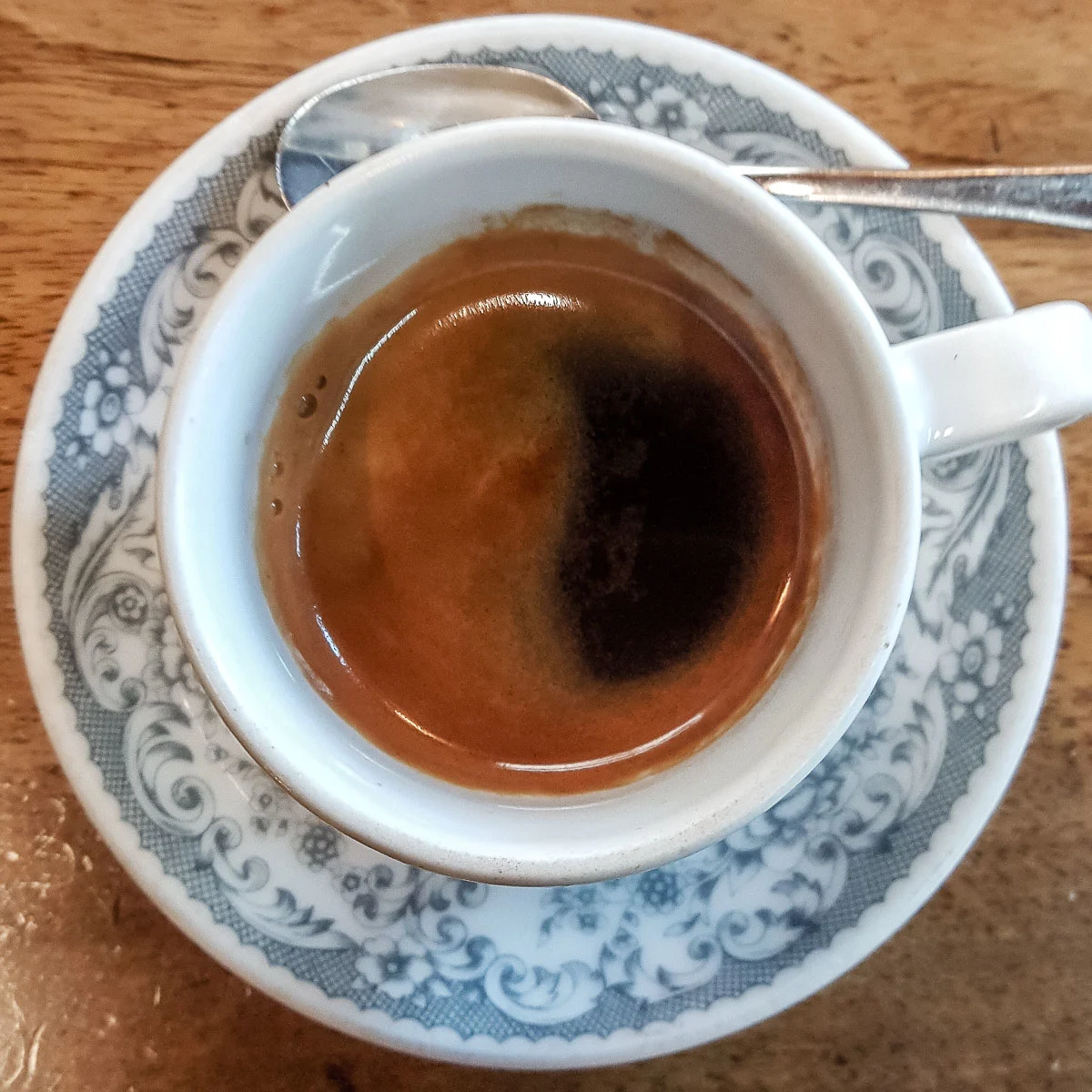
In order to enjoy an espresso at its best, it needs to be sipped at a temperature of about 60 degrees and not more than 2 minutes after being made. Italian coffee experts advise that 50% of the flavours of espresso dissipate within the first two minutes of making it.
In other words, don’t waste time chatting or looking around. The barista will serve you your coffee straight after it has been made. If you need to add sugar, do it diligently and then mix with delicate movements as described above. If you take your coffee without sugar, then just mix it for the reasons explained above.
Take a sip of water (if you have been served a tiny glass of water or if you have ordered one). Let it wash down your palate. Then take your first sip of coffee.
Enjoy the flavour explosion!
By the way, avoid blowing on your coffee to get it to cool down. It’s considered bad manners and, in any case, the two-minute rule guarantees maximum enjoyment.
14. Coffee Is for Sipping
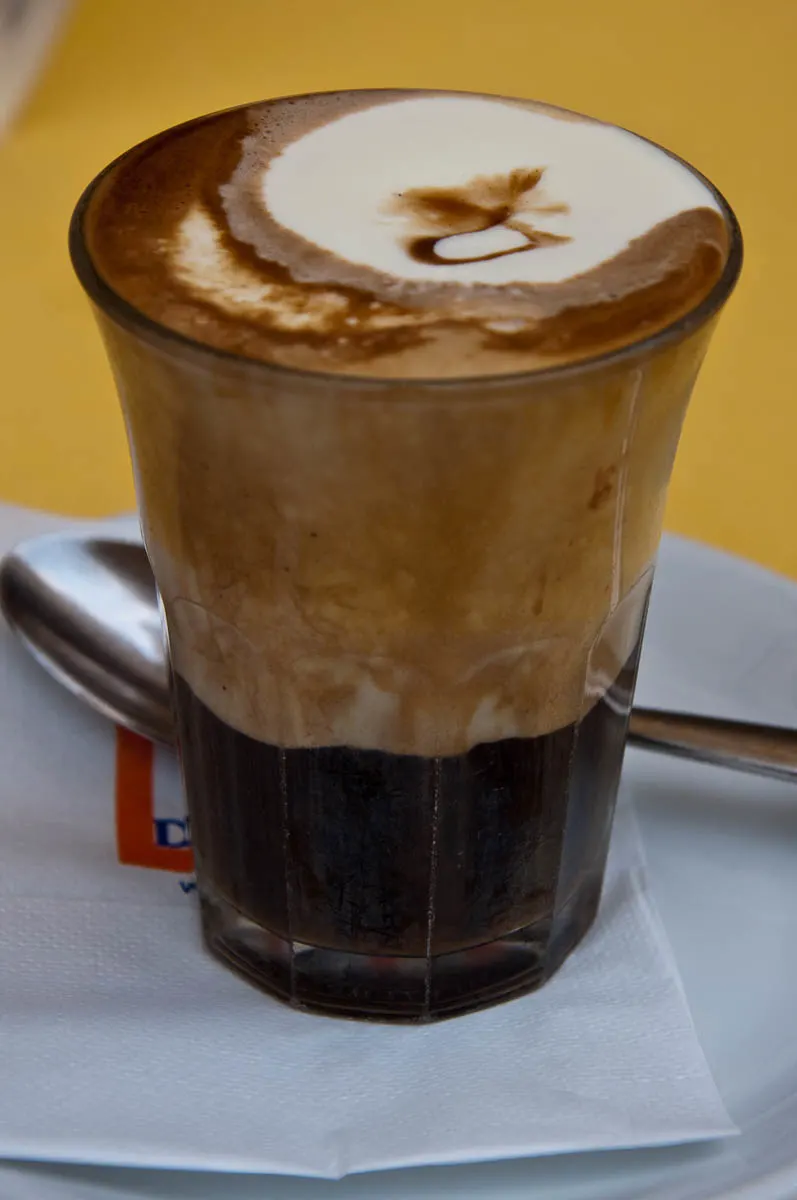
I have often read articles stating that Italians drink their caffè in one gulp. This is not true.
To fully appreciate the crema and the flavour of coffee, Italians drink their espressos in small sips. Three or four sips is all that it takes to empty a tiny espresso cup. Yet, each sip has maximised the sensation and the flavour, so it becomes a proper ritual.
If you take your espresso in one gulp, this will displace the crema and most of it will stick to the walls of your cup. Hence, you will miss out on taste and aroma.
Sipping your espresso instead guarantees that you are taking in both crema and liquid, thus enjoying the perfect marriage of flavour and heat.
15. Coffee in Italy Has a Local Character
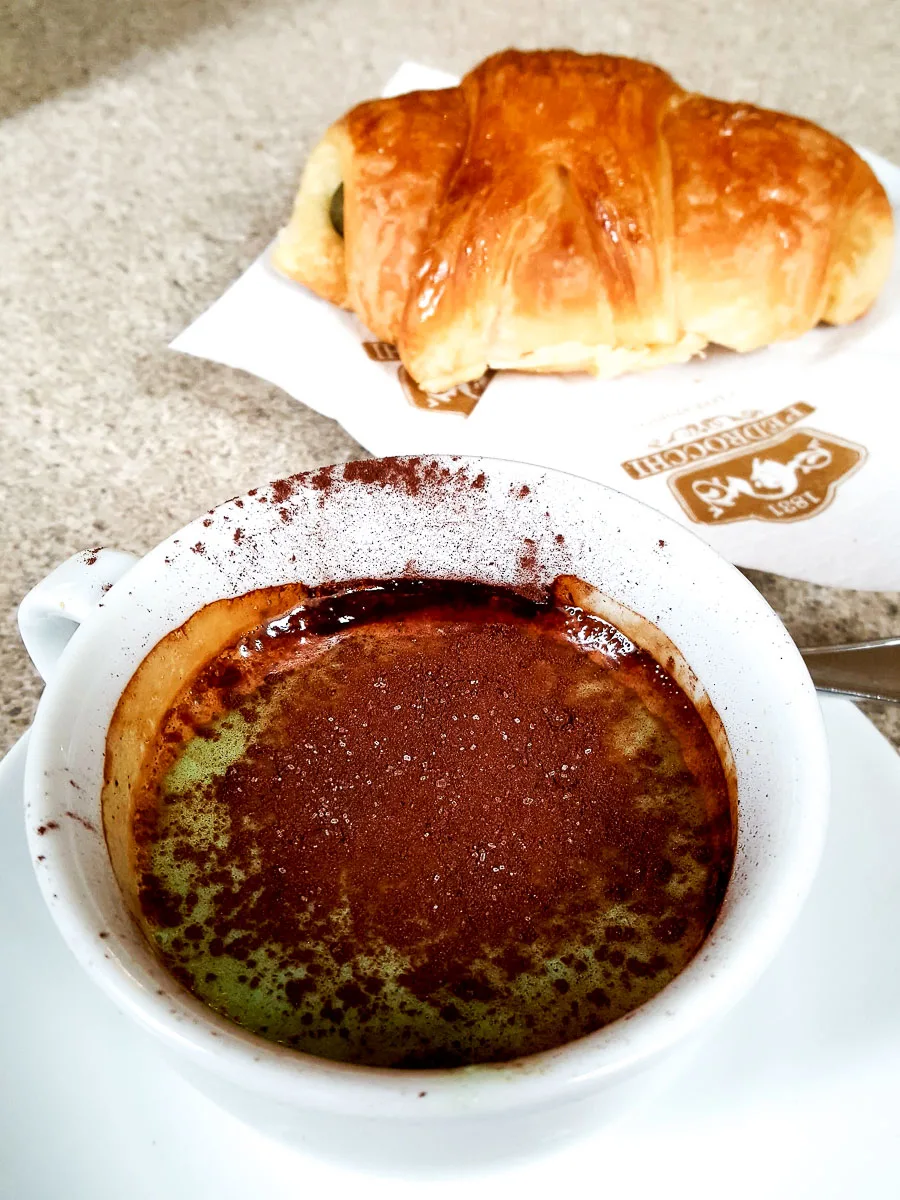
While espresso and cappuccino are staples all over Italy, there are many coffee drinks here that are typical for a particular place or region.
For example, in the Northern Italian region of the Veneto, macchiatone is a beloved local coffee drink. It’s something between a macchiato and a cappuccino. You can think of it either as a macchiato with lots of milk or as a compact cappuccino.
In Padua – one of the largest cities in the Veneto – they have their own very special coffee drink. It’s only made in the city’s historic coffee shop – Caffe’ Pedrocchi. The Pedrocchi coffee (pictured above) is a shot of 100% Arabica with mint syrup, whipped cream emulsion, and a dusting of bitter cocoa.
In Livorno – a city in Tuscany in Central Italy – they have a coffee drink called ponce. Its name comes from ‘punch’ in English. It is prepared with sugar, lemon peel, rum (which can be mixed with cognac or sassolino – an alcoholic drink from the province of Modena), and espresso ristretto.
So, when you are in Italy, always ask to try the local coffee drink! It’s a great introduction to little-known sides of Italian coffee culture
16. Summer in Italy Is for Cold Coffee Drinks
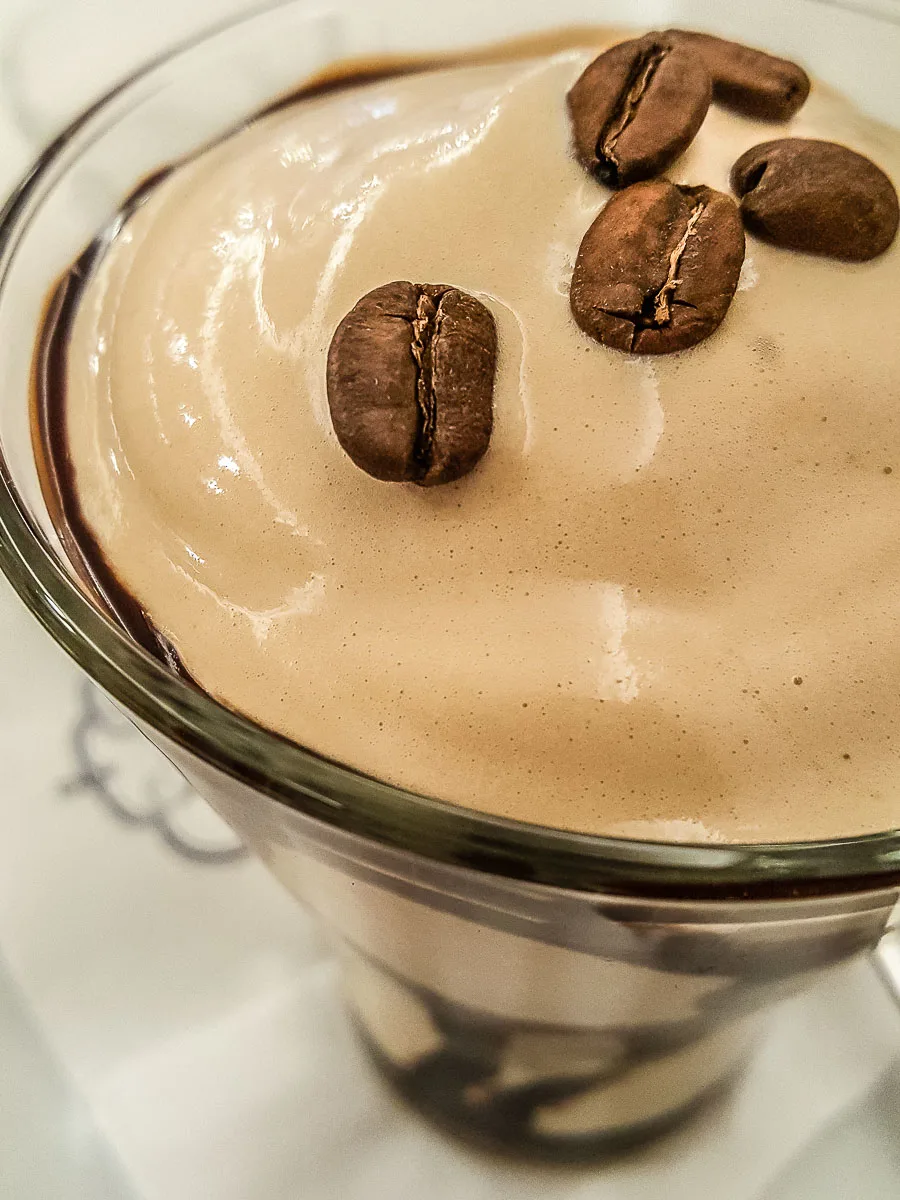
Summers in Italy are hot. To cool off, the Italians have developed several delicious cold coffee drinks.
Some of the most popular ones are caffè shakerato, caffè affogato, and my personal favourite – crema al caffè (pictured above). To learn more about them, have a look at this blog post:
17. Coffee Is Not Always Coffee in Italy

One of the most curious things about coffee in Italy is that it is not always prepared with actual coffee beans.
Looking at the menu of any cafe, bar, or patisserie here, you will soon notice drinks called caffè d’orzo and caffè al ginseng. The first is a hot drink made with barley. It’s excellent when you want a hot coffee-like drink but don’t want the caffeine injection. The other is a hot drink prepared with ginseng root extract mixed with coffee. It has a sweet nutty flavour and can be a very nice change to the kick that a strong Italian espresso gives.
Barley and ginseng root extract are used not just for espresso-type drinks in Italy. You can also ask to have your cappuccino or macchiato prepared with them if you wish. Also, you can buy both in Italian supermarkets and use them at home.
18. Forget Instant Coffee in Italy
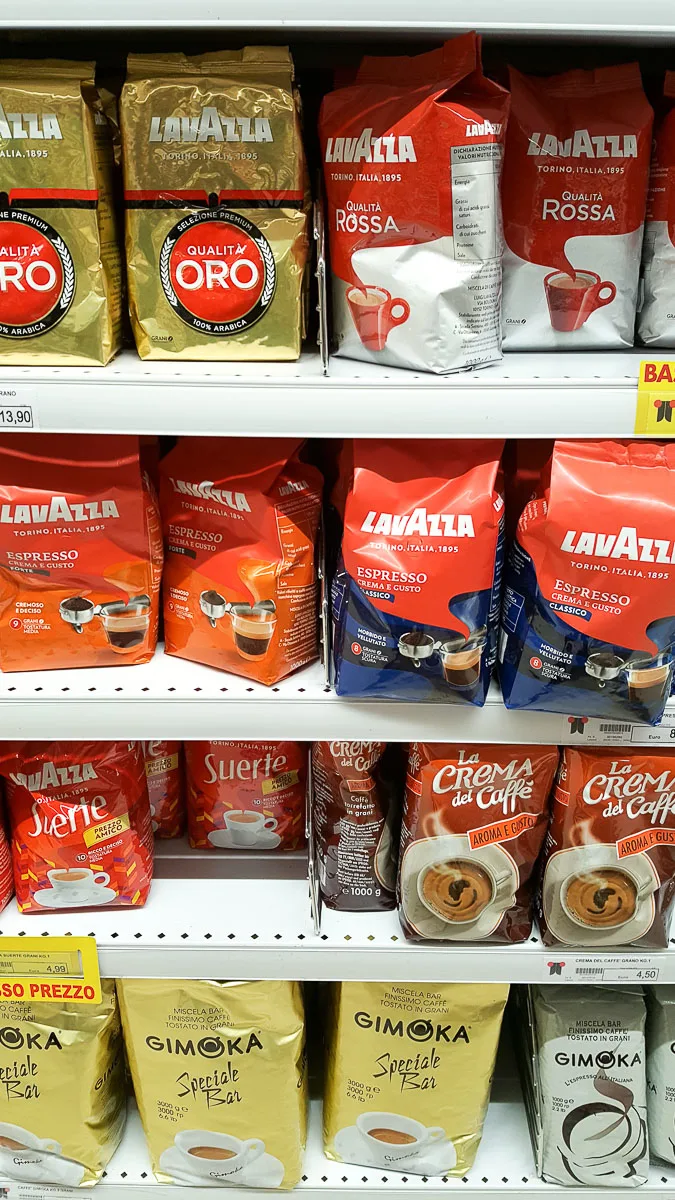
Instant coffee is not popular in Italy. Statistic data shows that while Italians consume almost 6 kg of coffee per capita each year, only 0.1 kg of it is instant coffee.
In general, Italian supermarkets sell a very limited selection of instant coffee and people simply don’t buy it. Traditionally, Italians choose quality over convenience and this applies full force to coffee. People in Italy would rather spend a bit of time each morning making a proper cup of coffee with their trusted Moka or beloved coffee pod machine.
I will admit that at the start of my life in Italy, I used to buy instant coffee out of habit and convenience. My local supermarket in Vicenza only sold two brands of instant coffee and I suspect, I was the only one buying it. Instead, it had a great selection of Italian coffee brands and all sorts of roasted coffee – both beans and ground.
By the end of my time in Italy, my Moka had developed a lovely patina. I had also thrown away my last jar of instant coffee after it had spent over a year sitting in the cupboard.
19. Moka is a Must
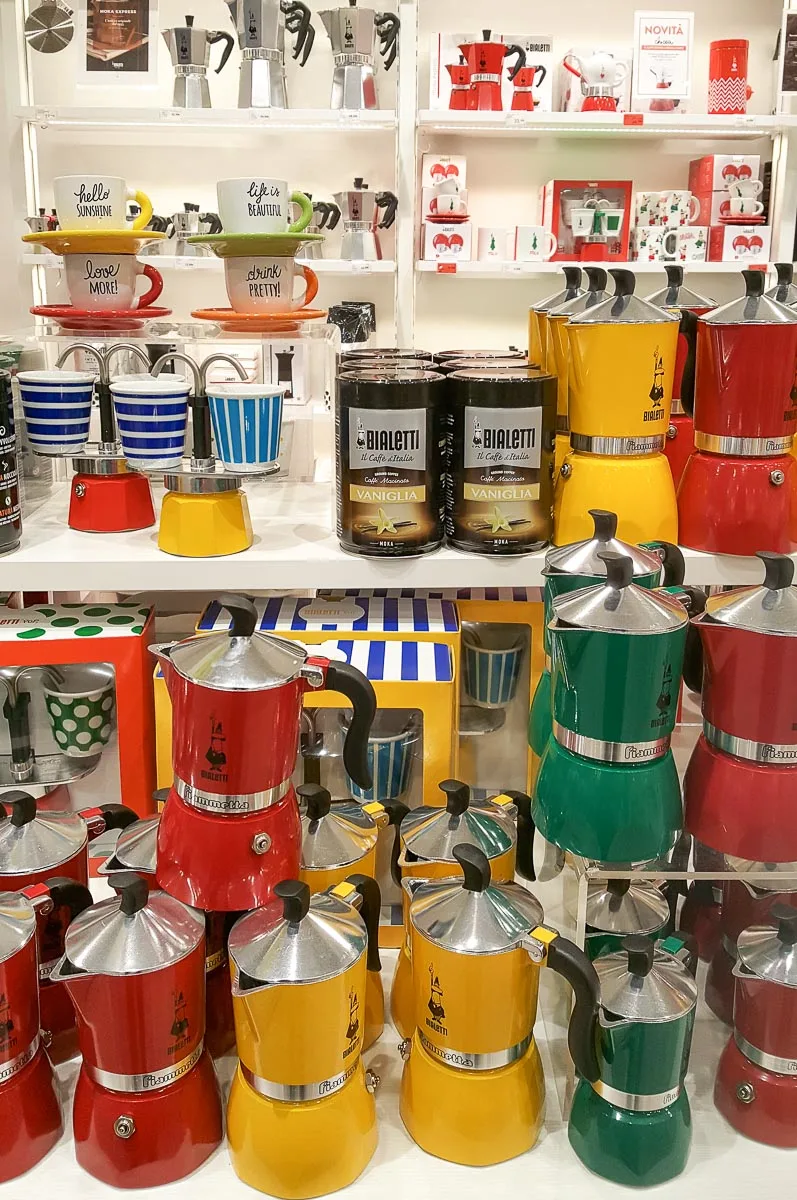
To fully embrace the Italian coffee culture both when you are in Italy and at home, you need to buy yourself a Moka!
This is Italy’s traditional coffee pot. It was invented by Angelo Bialetti and patented by him in 1933. A Moka has three parts – a bottom which you fill with water, a filter which you fill with ground coffee, and a top part which you screw to the bottom part with the filter in the middle. Then you put the Moka on the stove.
The Moka works thanks to the pressure of vapour (about 1 atmosphere). It pushes the boiling water from the bottom half of the pot up through the ground coffee in its middle and into the top half.
You will recognise a Moka pot by its iconic octagonal design and also by its mascot – a caricature of a moustached man with his arm lifted up and a finger pointing up as if asking for yet another espresso.
While using a Moka can seem a bit of a faff, especially at the beginning, do give it a try. The Moka itself is not expensive. Yet, it produces a very Italian fragrant strong coffee to enjoy in the comfort of your home.
In Conclusion
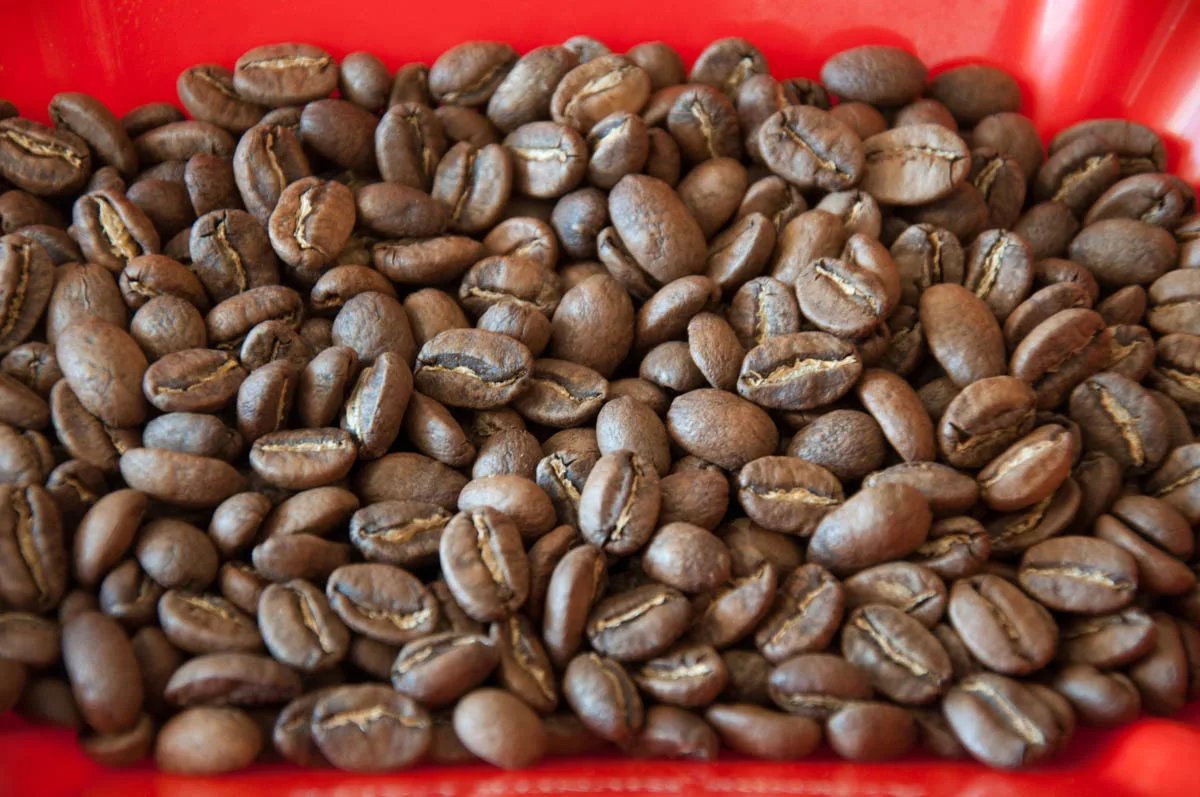
If you love coffee and Italy, you will want to learn more about the Italian coffee culture. Honed over several centuries, this is the coffee etiquette practised in Italy. Its goal is to obtain maximum coffee enjoyment.
In the above blog post, I share with you 19 rules of the Italian coffee culture. I discovered them one by one for myself during my six years of living in Italy. From how to mix your coffee (even if you don’t take sugar) to why Italians go to the bar when they want an espresso, all sorts of curious and helpful coffee information is covered.
If after reading this blog post, you want to read more about the history of Italian coffee culture, then have a look here:
I hope that you will find these two blog posts of interest and that they will help you enjoy Italian coffee at its best both during your visit to Italy and then back at home.
Thank you for reading!
More Helpful Links
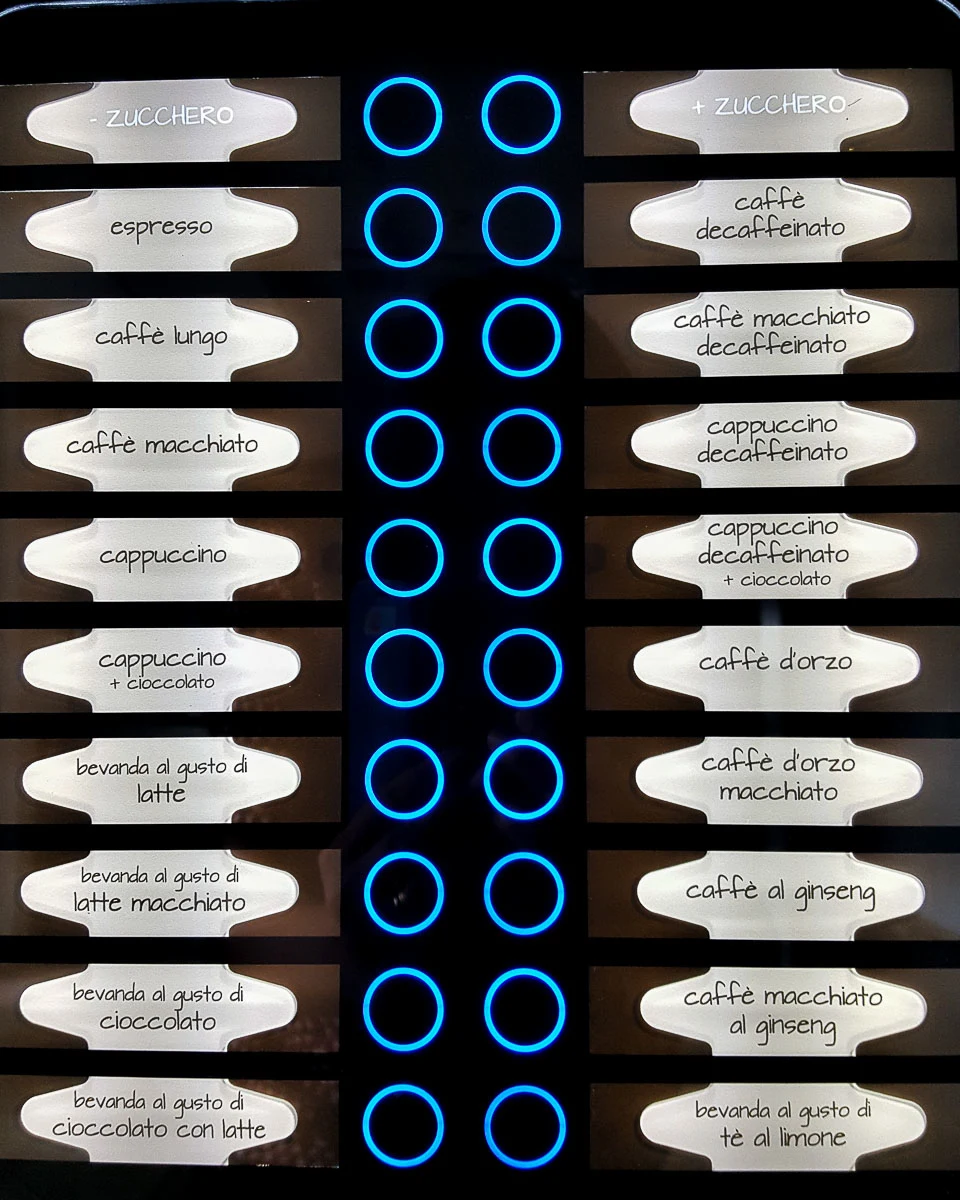
- Italian Cheeses – 5 Must-Try Cheeses and 10 Unmissable Cheese Experiences in the Veneto, Italy
- Italian Markets – 11 Types of Markets You Can Find in Italy
- Italian Food – 13 Ways to Eat Well in Italy Without Breaking the Bank
- What is Polenta Or 10 Reasons Why You Should Eat Polenta in Northern Italy
- Pasticceria Soraru – The Oldest Patisserie in Vicenza, Italy – Traditions and Secrets of Italian Desserts
- Exploring Venice: Rialto Fish Market
- Frittella – The Taste of the Venetian Carnival
- Panettone – Traditions and Secrets of the King of the Italian Christmas Table
- Mandorlato Veneto – The Taste of Italian Christmas
- Castagnata – Italy’s Roasted Chestnuts Festivals
- Sant’Antonio’s Cakes in Padua, Italy – The Story of the Sweets of the Saint
- The Tortellini of Valeggio sul Mincio
- CioccolandoVi – A Chocolate Festival in Vicenza, Italy
- Cremino – Three-Layered Chocolate Happiness
Thank you for reading! Please, leave me a comment, pin the image below or use the buttons right at the top and at the end of this blog post to share it on social media.
For more useful information like this, please, like my blog’s page on Facebook and subscribe to my strictly no-spam newsletter.
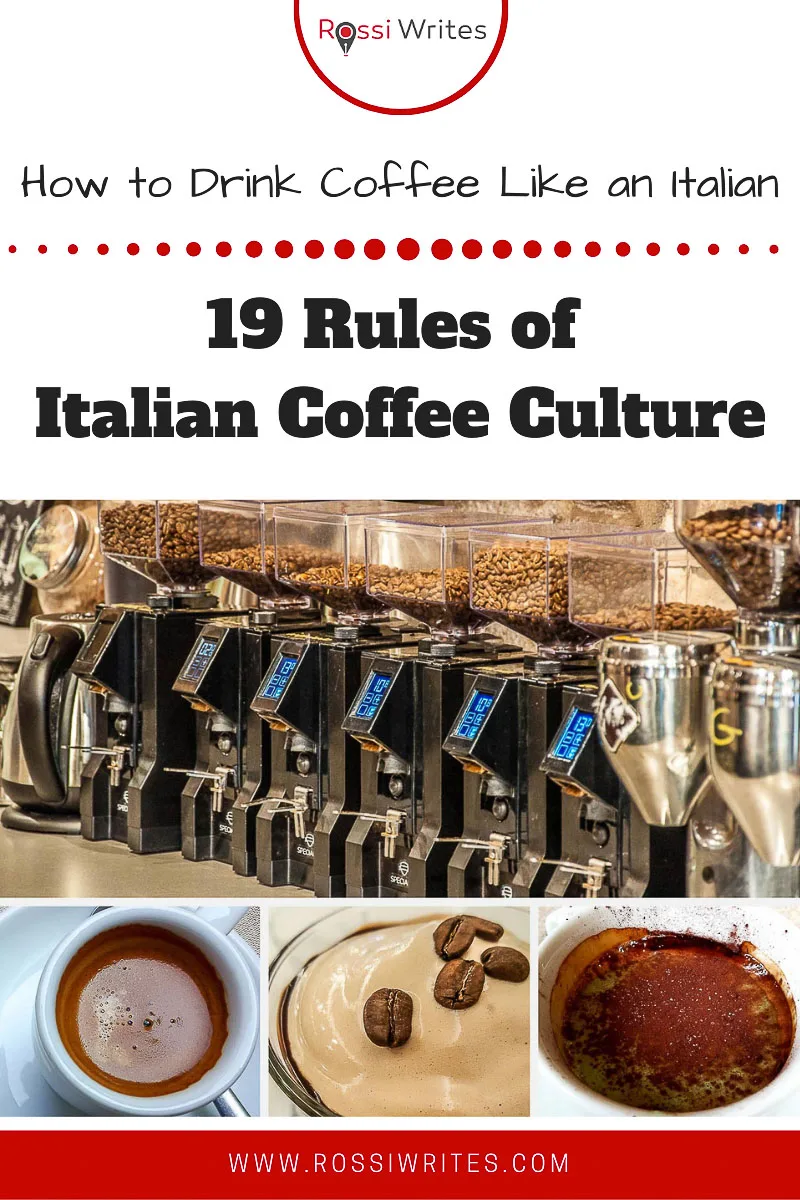

Looey
Saturday 23rd of December 2023
Great article, wish I had seen it sooner. My wife and I just spent 10 days in October in Orvieto and Trastevere with side trips to Siena and Assisi and with minor variations your article is spot on. We spent time in the morning observing at the bar and with two months of Italian lessons became very adept at ordering our colazione. You have offered us some interesting nuances to our coffee drinking next time we go. Thank you.
admin
Wednesday 27th of December 2023
Thank you for your kind words and for sharing your Italian experiences! Half of the charm of Italy is observing the local attitude to life and coffee drinking is such an important part of it.
Best wishes,
Rossi :)
Nisha Foerstner
Friday 10th of March 2023
Well, I spent many years in Italian cafes in Vancouver and now I am in Italy and find your article useful, not to mention, surprising. Thank you!
admin
Friday 10th of March 2023
Thank you for your kind words! Have a great time in Italy and enjoy the coffee! :)
Best wishes,
Rossi
Anusha
Thursday 2nd of March 2023
Great and informative article. Can’t wait to have my first cup of coffee in Bologna! ❣️
admin
Thursday 2nd of March 2023
Thank you for your kind words! Have a wonderful time in Bologna. It's a great city to explore in Italy.
Best wishes,
Rossi :)
Mohammed Bilal
Saturday 7th of January 2023
Beautifully written. Enjoyed every bit of it. What an amazing experience just reading your article. Thank you
admin
Saturday 7th of January 2023
Thank you for stopping by and for your kind words! Have a lovely day!
Rossi Thomson
2008taylorheald@gamil.com
Monday 14th of June 2021
I'm very new to your blog but this post was very helpful as I am trying to learn all about Italian coffee culture for when I move there. And I just wanted to say thank-you for your post
admin
Monday 14th of June 2021
Thank you for your kind words! I wish you a smooth move to Italy and lots of great moments getting acquainted with the Italian coffee in situ.
Best wishes,
Rossi :)